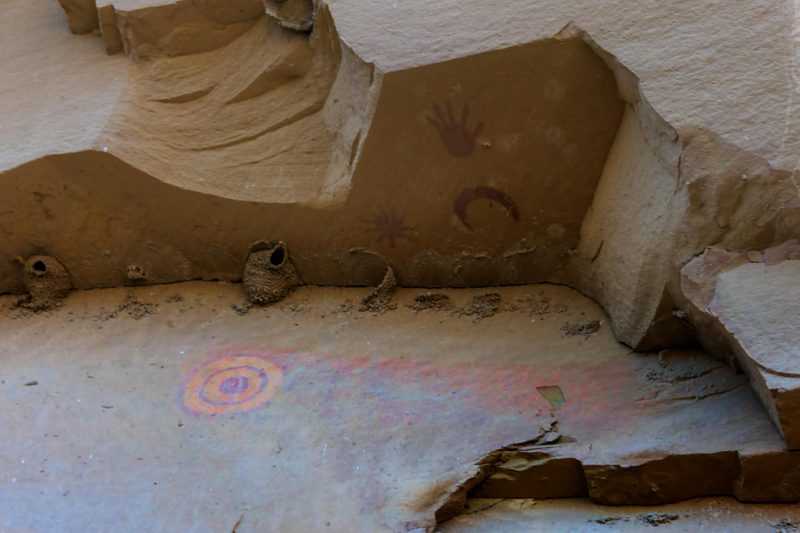
Chaco Canyon and its rock art
What once was called simply Chaco Canyon in remote northwestern New Mexico – known today as the Chaco Culture National Historical Park – is still accessible only by dirt roads. It’s an International Dark Sky Park with much to offer. Its skies are dark, the desert scenery is spectacular, and there are ancient pueblo ruins with astronomical pictographs. The ruins showcase the ancient Chacoan civilization, part of the Ancestral Puebloan culture that dominated much of what’s now the U.S. Southwest from the mid-9th to early 13th centuries. The Chacoan civilization built great houses and hosted large ceremonies, and many involved astronomy. A supernova, famous comet, total solar eclipse and the solstice must have been important events for the Chacoan people. Many of these events may have been documented in artwork on their walls.
Chacoan civilization was at its height in the 11th century, which coincided with spectacular astronomical events visible from the canyon. Two of these events were supernovas, in 1006 and 1054, which were visible during the day. Another event was a total solar eclipse that passed over the region on July 11, 1097. Additionally, the benchmark 1066 appearance of Halley’s Comet happened within this time period.
Chaco Canyon’s large collection of petroglyphs and pictographs likely include representations of these spectacular events. The rock art preserves the Chaco culture’s experience of these important events and allows us to see the skies through the eyes of our ancestors.
The 2022 lunar calendars are here. Order yours before they’re gone!
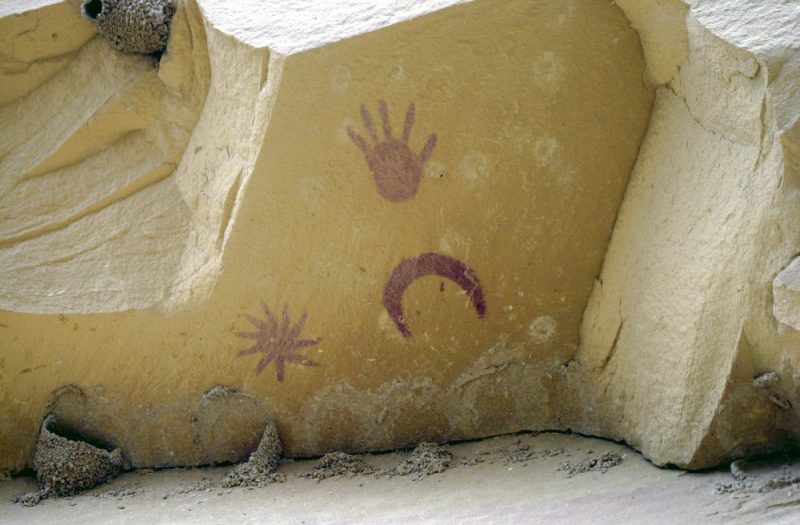
Supernova Pictograph: What did they see?
Two remarkable pictographs are located along the trail from Chaco Wash to the Peñasco Blanco great house. The Supernova Pictograph is well preserved on a shaded horizontal rock face 16 feet (about 5 meters) above the trail. Adjacent to it on a vertical rock face is a barely visible pictograph that may be a representation of Halley’s Comet or the sun during an eclipse.
Although the connection remains controversial, the Supernova Pictograph is often mentioned in association with the supernova of 1054, the parent supernova of the still-visible Crab Nebula. The construction of the Peñasco Blanco great house, directly above the pictograph near the canyon rim, lasted from 900 to 1125 CE. The orientation of the star to the right of the crescent (if you picture the artist head in, on his back) corresponds to the pre-dawn appearance of the supernova and the moon on July 5, 1054, directly across the canyon. Historical records show that Chinese observers had first sighted the supernova of 1054 the day before (July 4, 1054). On July 5, it would have been visible in daylight, and near its peak brightness.
Other possible subjects for this image include the moon and Venus, as well as the even brighter supernova of 1006. Although brighter, the supernova of 1006 was very low on the southern horizon for the latitude of New Mexico. It wouldn’t have been easily visible from this location on the southwest wall of the canyon.

Another pictograph: Mysterious and colorful
Below the possible supernova is a very faded pictograph, originally in red and yellow. The concentric circles suggest representations of the sun. The feathered or flaming-looking tail to the side might be a representation of a coronal mass ejection (CME) during the total solar eclipse of July 11, 1097. Visible from Chaco, near the peak of a solar cycle, a CME might have given the corona an asymmetric appearance during totality.
Yet, looking at the enhanced image at the top of this post, the appearance closely resembles a comet’s tail. The spectacular 1066 appearance of Halley’s Comet was only 12 years after the supernova of 1054. The proximity of the two images leads me to favor the Halley’s Comet interpretation.
More precise dating could narrow down possible interpretations. Dating of pictographs is possible, but requires removal of part of the image. More precise dating evidence could eliminate possibilities but not prove a specific interpretation.
So we’ll probably never know – for certain – the subjects of these pictographs. The dates, location and the orientation of the image provide compelling evidence for the supernova of 1054 interpretation. The adjacent pictograph looks very cometlike to the modern eye and the proximity of dates makes the 1066 appearance of Halley’s Comet plausible.
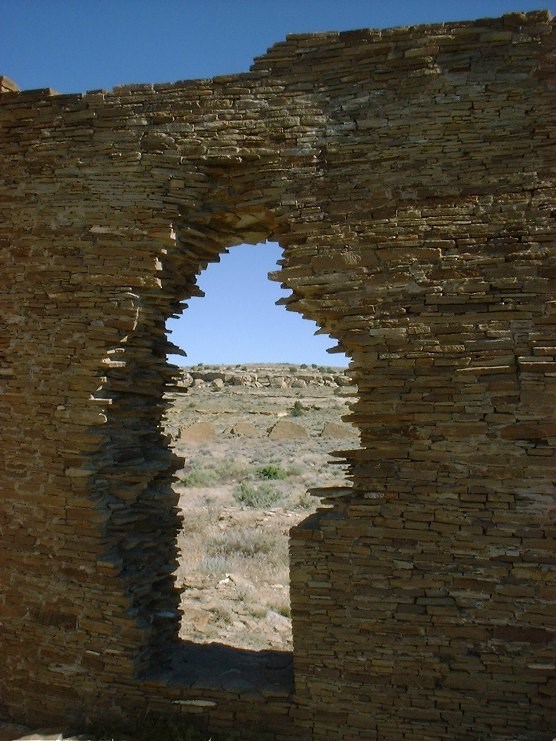
The Sun Dagger at Chaco Canyon
The Sun Dagger is a spiral rock art, constructed so that a sliver of light would cut through the center of the spiral on the summer solstice. It’s located at Fajada Butte, which rises some 400 feet (120 meters) above the Chaco Canyon desert floor.
A thousand years ago, the Sun Dagger confirmed the height of summer to the ancient astronomers who lived in Chaco Canyon. These ancient people, by the way, are still sometimes referred to as Anasazi, although that name is a word taken from the language of other nearby peoples, the Utes and Navajos. In the Ute language, Anasazi meant “ancient ones” or “ancestral enemies.” The Sun Dagger remained hidden until 1977, when it was inadvertently “rediscovered” during a time that researchers were studying and cataloguing known or suspected rock art and petroglyphs on Fajada Butte.
Today, the Sun Dagger is no longer open for viewing by the public. Foot traffic in the area caused the stones that create the slit of light to shift. Rangers shored up the area but did not readjust the rocks. Since then, this area has been closed.
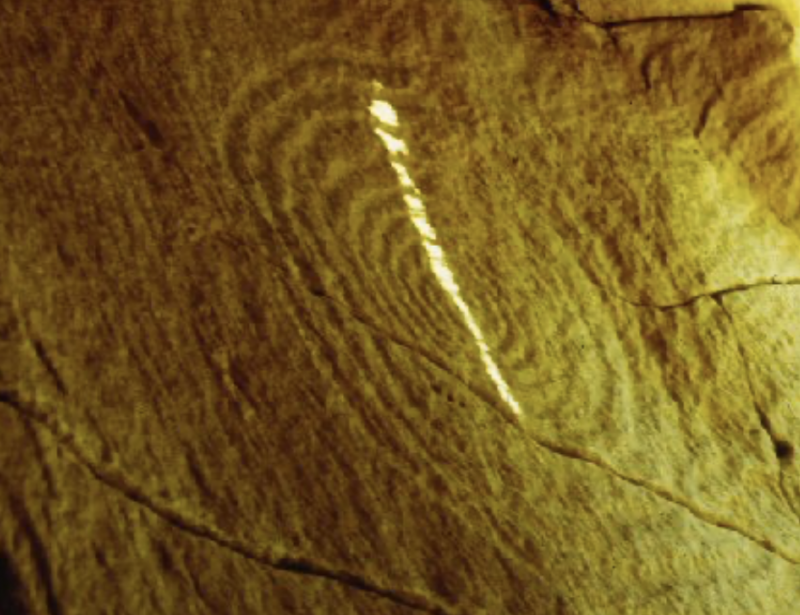
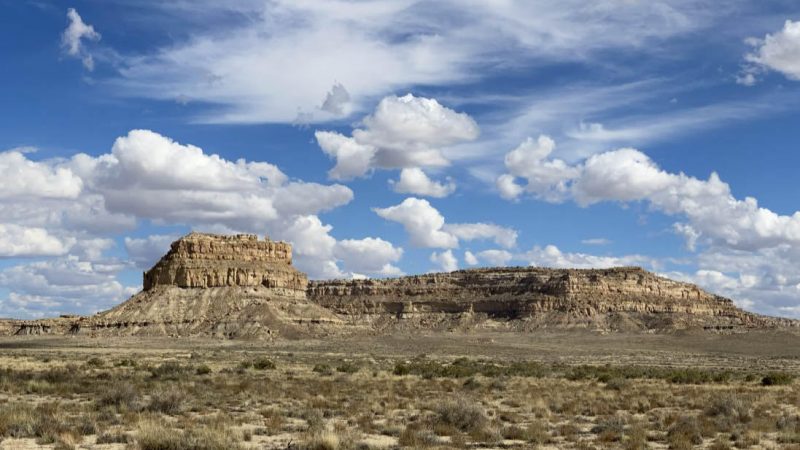
Visiting Chaco Culture National Historical Park
Reaching Chaco Culture National Historical Park in northwest New Mexico requires travel over erratically maintained dirt roads and a low-water crossing across the Escavada Wash. The location is a dry high desert with temperatures ranging from hot in the summer to below freezing in the winter. Flash floods are a concern, particularly during the monsoon, and it snows in the winter. Camping with potable water is available by reservation for visitors to the park, but food, other than a few snacks, is not.
Once in the canyon, reaching the pictograph site requires a 6-mile (10-km) round trip on relatively flat trails from the Peñasco Blanco trailhead, off the park’s loop road. Altitude, very low humidity and temperatures from freezing to 100 degrees Fahrenheit in summer can make the hike a challenge. When water is running in Chaco Wash – the arroyo or periodic stream that cuts through Chaco Canyon – it’s often impassible. On our trip, we found Chaco Wash was an 8-foot (2.4 m) wide, and 6-foot (2 m) deep muddy ditch, with about a foot (0.3 m) of water running in it. Steep, slippery sides with “quicksand” and about a foot of water made crossing the wash a real adventure.
Chaco Canyon has star gazing and astrophotography opportunities worthy of its status as an IDA International Dark Sky Park. I took the image of Fajada Butte (site of the Sun Dagger) with an earthshine crescent moon before my hike out from the Supernova Pictograph.
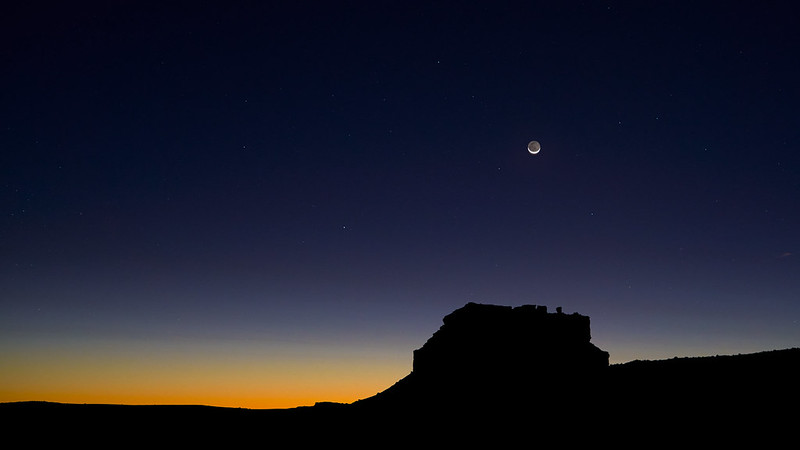

Bottom line: Chaco Culture National Historical Park contains astronomical rock art that documents what the people of the time saw in the sky.
The post Chaco Canyon in New Mexico, and its astronomical rock art first appeared on EarthSky.
from EarthSky https://ift.tt/3F3j2O7

Chaco Canyon and its rock art
What once was called simply Chaco Canyon in remote northwestern New Mexico – known today as the Chaco Culture National Historical Park – is still accessible only by dirt roads. It’s an International Dark Sky Park with much to offer. Its skies are dark, the desert scenery is spectacular, and there are ancient pueblo ruins with astronomical pictographs. The ruins showcase the ancient Chacoan civilization, part of the Ancestral Puebloan culture that dominated much of what’s now the U.S. Southwest from the mid-9th to early 13th centuries. The Chacoan civilization built great houses and hosted large ceremonies, and many involved astronomy. A supernova, famous comet, total solar eclipse and the solstice must have been important events for the Chacoan people. Many of these events may have been documented in artwork on their walls.
Chacoan civilization was at its height in the 11th century, which coincided with spectacular astronomical events visible from the canyon. Two of these events were supernovas, in 1006 and 1054, which were visible during the day. Another event was a total solar eclipse that passed over the region on July 11, 1097. Additionally, the benchmark 1066 appearance of Halley’s Comet happened within this time period.
Chaco Canyon’s large collection of petroglyphs and pictographs likely include representations of these spectacular events. The rock art preserves the Chaco culture’s experience of these important events and allows us to see the skies through the eyes of our ancestors.
The 2022 lunar calendars are here. Order yours before they’re gone!

Supernova Pictograph: What did they see?
Two remarkable pictographs are located along the trail from Chaco Wash to the Peñasco Blanco great house. The Supernova Pictograph is well preserved on a shaded horizontal rock face 16 feet (about 5 meters) above the trail. Adjacent to it on a vertical rock face is a barely visible pictograph that may be a representation of Halley’s Comet or the sun during an eclipse.
Although the connection remains controversial, the Supernova Pictograph is often mentioned in association with the supernova of 1054, the parent supernova of the still-visible Crab Nebula. The construction of the Peñasco Blanco great house, directly above the pictograph near the canyon rim, lasted from 900 to 1125 CE. The orientation of the star to the right of the crescent (if you picture the artist head in, on his back) corresponds to the pre-dawn appearance of the supernova and the moon on July 5, 1054, directly across the canyon. Historical records show that Chinese observers had first sighted the supernova of 1054 the day before (July 4, 1054). On July 5, it would have been visible in daylight, and near its peak brightness.
Other possible subjects for this image include the moon and Venus, as well as the even brighter supernova of 1006. Although brighter, the supernova of 1006 was very low on the southern horizon for the latitude of New Mexico. It wouldn’t have been easily visible from this location on the southwest wall of the canyon.

Another pictograph: Mysterious and colorful
Below the possible supernova is a very faded pictograph, originally in red and yellow. The concentric circles suggest representations of the sun. The feathered or flaming-looking tail to the side might be a representation of a coronal mass ejection (CME) during the total solar eclipse of July 11, 1097. Visible from Chaco, near the peak of a solar cycle, a CME might have given the corona an asymmetric appearance during totality.
Yet, looking at the enhanced image at the top of this post, the appearance closely resembles a comet’s tail. The spectacular 1066 appearance of Halley’s Comet was only 12 years after the supernova of 1054. The proximity of the two images leads me to favor the Halley’s Comet interpretation.
More precise dating could narrow down possible interpretations. Dating of pictographs is possible, but requires removal of part of the image. More precise dating evidence could eliminate possibilities but not prove a specific interpretation.
So we’ll probably never know – for certain – the subjects of these pictographs. The dates, location and the orientation of the image provide compelling evidence for the supernova of 1054 interpretation. The adjacent pictograph looks very cometlike to the modern eye and the proximity of dates makes the 1066 appearance of Halley’s Comet plausible.

The Sun Dagger at Chaco Canyon
The Sun Dagger is a spiral rock art, constructed so that a sliver of light would cut through the center of the spiral on the summer solstice. It’s located at Fajada Butte, which rises some 400 feet (120 meters) above the Chaco Canyon desert floor.
A thousand years ago, the Sun Dagger confirmed the height of summer to the ancient astronomers who lived in Chaco Canyon. These ancient people, by the way, are still sometimes referred to as Anasazi, although that name is a word taken from the language of other nearby peoples, the Utes and Navajos. In the Ute language, Anasazi meant “ancient ones” or “ancestral enemies.” The Sun Dagger remained hidden until 1977, when it was inadvertently “rediscovered” during a time that researchers were studying and cataloguing known or suspected rock art and petroglyphs on Fajada Butte.
Today, the Sun Dagger is no longer open for viewing by the public. Foot traffic in the area caused the stones that create the slit of light to shift. Rangers shored up the area but did not readjust the rocks. Since then, this area has been closed.


Visiting Chaco Culture National Historical Park
Reaching Chaco Culture National Historical Park in northwest New Mexico requires travel over erratically maintained dirt roads and a low-water crossing across the Escavada Wash. The location is a dry high desert with temperatures ranging from hot in the summer to below freezing in the winter. Flash floods are a concern, particularly during the monsoon, and it snows in the winter. Camping with potable water is available by reservation for visitors to the park, but food, other than a few snacks, is not.
Once in the canyon, reaching the pictograph site requires a 6-mile (10-km) round trip on relatively flat trails from the Peñasco Blanco trailhead, off the park’s loop road. Altitude, very low humidity and temperatures from freezing to 100 degrees Fahrenheit in summer can make the hike a challenge. When water is running in Chaco Wash – the arroyo or periodic stream that cuts through Chaco Canyon – it’s often impassible. On our trip, we found Chaco Wash was an 8-foot (2.4 m) wide, and 6-foot (2 m) deep muddy ditch, with about a foot (0.3 m) of water running in it. Steep, slippery sides with “quicksand” and about a foot of water made crossing the wash a real adventure.
Chaco Canyon has star gazing and astrophotography opportunities worthy of its status as an IDA International Dark Sky Park. I took the image of Fajada Butte (site of the Sun Dagger) with an earthshine crescent moon before my hike out from the Supernova Pictograph.


Bottom line: Chaco Culture National Historical Park contains astronomical rock art that documents what the people of the time saw in the sky.
The post Chaco Canyon in New Mexico, and its astronomical rock art first appeared on EarthSky.
from EarthSky https://ift.tt/3F3j2O7

Aucun commentaire:
Enregistrer un commentaire